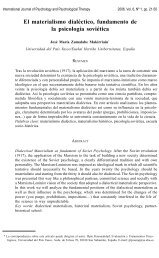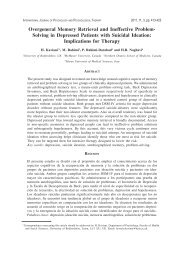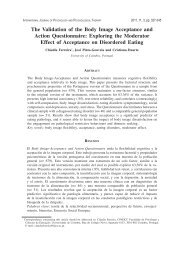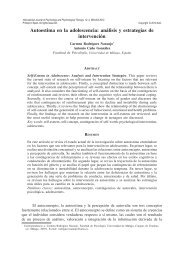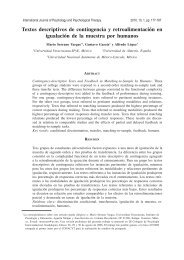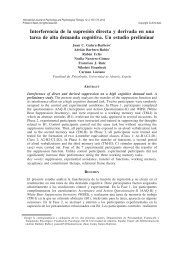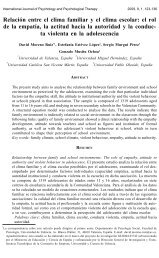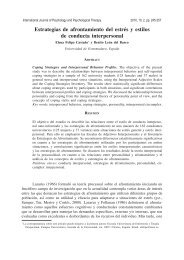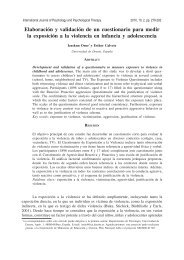English (PDF) - International Journal of Psychology and ...
English (PDF) - International Journal of Psychology and ...
English (PDF) - International Journal of Psychology and ...
Create successful ePaper yourself
Turn your PDF publications into a flip-book with our unique Google optimized e-Paper software.
<strong>International</strong> <strong>Journal</strong> <strong>of</strong> <strong>Psychology</strong> <strong>and</strong> Psychological Therapy 2010, 10, 2, pp. 331-343<br />
The Hindi Adaptation <strong>and</strong> St<strong>and</strong>ardization <strong>of</strong> the<br />
Proactive Coping Inventory (PCI)<br />
Braj Bhushan *1 , Ruchi Gautam 2 <strong>and</strong> Esther R. Greenglass 3<br />
1<br />
Indian Institute <strong>of</strong> Technology Kanpur, India 2<br />
Indian Institute <strong>of</strong> Technology Kanpur, India<br />
3<br />
York University, Canada<br />
Abstract<br />
In this paper we present the Hindi adaptation <strong>of</strong> Proactive Coping Inventory (PCI). All<br />
the 55 items were translated into Hindi by independent translators. A consensus version<br />
(moderation) <strong>of</strong> these translations was developed looking at the language <strong>and</strong> cultural<br />
suitability <strong>of</strong> the words. Thereafter, backward translations <strong>of</strong> the moderated version were<br />
performed to check semantic discrepancies. After measuring item equivalence, we st<strong>and</strong>ardized<br />
the Hindi version <strong>of</strong> PCI on a representative sample <strong>of</strong> senior citizens. Contrary<br />
to the proposition <strong>of</strong> the original scale, a fourteen factor solution emerged out <strong>of</strong> the<br />
factor analysis. The factor structure <strong>and</strong> reliability coefficients were compared between<br />
the original PCI <strong>and</strong> the Hindi version <strong>of</strong> PCI.<br />
Key words: Proactive Coping Inventory, factor analysis.<br />
Resumen<br />
En este artículo se presenta la adaptación al hindi del Inventario de Afrontamiento<br />
Proactivo (PCI). Los cincuenta y cinco ítems fueron traducidos al hindi por traductores<br />
independientes, lleg<strong>and</strong>o a una versión de consenso que tuvo en cuenta el significado y<br />
la oportunidad cultural de las palabras, y realiz<strong>and</strong>o traducciones de la versión moderada<br />
para verificar discrepancias semánticas. Después de medir la equivalencia de los ítems, se<br />
est<strong>and</strong>arizó la versión hindi del PCI en una muestra representativa de personas mayores.<br />
Al contrario que en la escala original, los resultados indicaron una solución de catorce<br />
factores. Se comparan la estructura factorial y los coeficientes de fiabilidad entre las<br />
versiones original e hindi del PCI.<br />
Palabras clave: inventario de afrontamiento proactivo, análisis factorial.<br />
Several researchers have attempted parsimonious classification <strong>of</strong> coping dimensions.<br />
A review <strong>of</strong> literature shows that researchers have proposed variety <strong>of</strong> coping<br />
dimensions, mostly as pairs. For example, primary versus secondary control (Rothbaum,<br />
Weisz, & Snyder, 1982), mastery versus meaning (Taylor, 1983), problem-focused versus<br />
emotion-focused coping (Lazarus, 1991), <strong>and</strong> assimilative versus accommodative coping<br />
(Br<strong>and</strong>tstädter, 1992). The primary-secondary control <strong>and</strong> mastery-meaning strategies<br />
may be temporal in nature. For example, ‘when individuals first try to alter the dem<strong>and</strong>s<br />
that are at stake, <strong>and</strong>, after failing, turn inward to reinterpret their plight <strong>and</strong><br />
*<br />
Correspondence to the first author: Department <strong>of</strong> Humanities & Social Sciences, Indian Institute <strong>of</strong> Technology Kanpur,<br />
Kanpur- 208 016, INDIA. E-mail: brajb@iitk.ac.in. Acknowledgment: Our thanks are due to Stephen G. Sireci <strong>and</strong><br />
John Hattie for their comments on the earlier version <strong>of</strong> this manuscript.
332<br />
BHUSHAN<br />
find subjective meaning in it’ (Schwarzer & Taubert, 2002, p. 4). Br<strong>and</strong>tstädter’s (1992)<br />
assimilative <strong>and</strong> accommodative coping preferences stress on modification. Assimilative<br />
coping refers to modification <strong>of</strong> the environment whereas accommodative coping refers<br />
to self-modification. Lazarus (1991) proposed two types <strong>of</strong> coping, namely problemfocused<br />
<strong>and</strong> emotion-focused coping. Problem-focused coping strategies are efforts to do<br />
something active to alleviate stressful circumstances, whereas emotion-focused coping<br />
strategies involve efforts to regulate the emotional consequences <strong>of</strong> stressful or potentially<br />
stressful events. According to Folkman <strong>and</strong> Lazarus (1980) people use both types<br />
<strong>of</strong> strategies to combat stressful events. Studies indicate that problem focused coping<br />
(Armeli, Gunthert, & Cohen, 2001; Evers, Kraaimaat, van Lankveld, Jonjen, Jacobbs,<br />
& Bijlsma, 2001; Koenig, Pargament, & Nielsen, 1998; Maercker & Langner, 2001)<br />
including acceptance, positive reinterpretation <strong>and</strong> positive religious coping (Koenig<br />
et al., 1998) are positively associated with growth. Emotion focused coping including<br />
emotional social support is also reportedly positively associated with growth (Maerker<br />
& Langer, 2001).<br />
Traditionally coping has been considered to occur in the aftermath <strong>of</strong> a stressful<br />
situation. But now psychologists do talk <strong>of</strong> proactive coping (Greenglass, Schwarzer,<br />
Jakubiec, Fiksenbaum, & Taubert, 1999; Greenglass, Schwarzer, & Taubert 1999).<br />
Schwarzer (2000) has proposed reactive, anticipatory, preventive, <strong>and</strong> proactive coping<br />
classifying coping strategies into four categories. Proactive coping is inherently different<br />
from the remaining three strategies encompassing three distinct features. According to<br />
Greenglass (2002), ‘it integrates planning <strong>and</strong> preventive strategies with proactive selfregulatory<br />
goal attainment; it integrates proactive goal attainment with identification<br />
<strong>and</strong> utilization <strong>of</strong> social resources; <strong>and</strong> it utilizes proactive emotional coping for selfregulatory<br />
goal attainment’ (p. 41). Further, it also ‘incorporates a confirmatory <strong>and</strong><br />
positive approach to dealing with stressors…[<strong>and</strong>]… integrates processes <strong>of</strong> personal<br />
quality <strong>of</strong> life management with those <strong>of</strong> self-regulatory goal attainment’ (Greenglass,<br />
2002, p. 37). It is deemed as future-oriented strategies that synchronize one’s resources<br />
to deal with stressful life situations before they occur. Inclination towards proactive<br />
coping style means that the individual is more resourceful, responsible <strong>and</strong> principled<br />
(Schwarzer, 1999).<br />
Early version <strong>of</strong> the proactive coping inventory was aiming the evaluation <strong>of</strong><br />
proactive cognition <strong>and</strong> positive behaviour towards coping with a 137-item scale comprising<br />
<strong>of</strong> 18 sub-scales. It intended to measure five dimensions (Greenglass, 1998). The<br />
present version by Greenglass et al. (1999) consists <strong>of</strong> 55 items measuring seven dimensions<br />
-proactive, reflective, strategic, preventive, instrumental, emotional, <strong>and</strong> avoidance<br />
coping. This is a four-point scale with 1 indicating ‘not at all true’, 2 ‘barely true’, 3<br />
‘somewhat true’ <strong>and</strong> 4 ‘completely true’. Reverse scoring is done only for items 2, 9,<br />
<strong>and</strong> 14. Higher score represent that the individual concerned is more inclined towards<br />
that particular coping style.<br />
Proactive Coping Inventory (PCI; Greenglass, Schwarzer, Jakubiec, Fiksenbaum,<br />
& Taubert, 1999) was developed <strong>and</strong> st<strong>and</strong>ardized on Canadian (Greenglass, 2002)<br />
<strong>and</strong> Polish-Canadian (Pasikowski, Sek, Greenglass, & Taubert, 2002) samples. Within<br />
a decade it has been translated into Arabic (Abdallah & Greenglass, 2005), Chinese<br />
© <strong>International</strong> <strong>Journal</strong> <strong>of</strong> <strong>Psychology</strong> & Psychological Therapy, 2010, 10, 2 http://www. ijpsy. com
PCI HINDI ADAPTATION 333<br />
(Cheng & Greenglass, 2006), Czech (Šolcová & Greenglass, 2005; Šolcová, Lukavsky,<br />
& Greenglass, 2006), German (Schwarzer, Greenglass, & Taubert, 2000), Spanish (Gutiérrez<br />
Doña, Greenglass, & Schwarzer, 2002), Hebrew (Etzion & Greenglass, 2004),<br />
Italian (Comunian, Greenglass, & Schwarzer, 2003), Japanese (Takeuchi & Greenglass,<br />
2004), Polish (Sęk, Pasikowski, Taubert, Greenglass, & Schwarzer, 1999), Portuguese<br />
(Marques, Lemos, & Greenglass, 2005), Turkish (Uskul, Greenglass, & Schwarzer,<br />
2002), Russian (Utkina, Radionova, & Greenglass, 2005), <strong>and</strong> Serbian (Djordjevic<br />
& Greenglass, 2006). Adaptation <strong>of</strong> an established scale has certain advantage over<br />
developing a new scale. Cross- language instruments give a mutual set <strong>of</strong> concepts<br />
<strong>and</strong> operational definition besides providing a sense <strong>of</strong> security when we are going to<br />
use an established <strong>and</strong> valid test (Brislin, 1986). Adaptation <strong>of</strong> an existing instrument<br />
further facilitates comparative cross-cultural studies cutting across national <strong>and</strong> ethnic<br />
boundaries (Hambleton & Kanjee, 1995).<br />
This paper describes the Hindi adaptation <strong>and</strong> st<strong>and</strong>ardization <strong>of</strong> the PCI. Anticipating<br />
that coping is a process that is evident all through the life, this study st<strong>and</strong>ardized<br />
PCI on a geriatric sample. This was an attempt to provide a tool for assessment<br />
<strong>of</strong> coping strategies <strong>and</strong> its effect in the elderly population. We developed the Hindi<br />
version following all the steps such as forward <strong>and</strong> backward translations, testing<br />
item equivalence with a bilingual sample, <strong>and</strong> st<strong>and</strong>ardization with a separate sample.<br />
Although several scales have been adapted <strong>and</strong> reported till date, we also aimed at<br />
bringing forward the comprehensive translations procedures <strong>and</strong> other ideal steps for<br />
test adaptation in accordance with the guidelines <strong>of</strong> the <strong>International</strong> Test Commission.<br />
Method<br />
Translation process<br />
St<strong>and</strong>ard guidelines were followed for translation <strong>of</strong> PCI adhering to the <strong>International</strong><br />
Test Commission Guidelines (Van de Vijver & Hambleton, 1996). Accordingly<br />
repeated forward-backward translation procedure was adopted. Instead <strong>of</strong> solitary translator<br />
method committee approach was followed to reduce the possibility <strong>of</strong> error (Butcher,<br />
1996). At the first step three native Indians worked as independent translators. They<br />
were good at speaking <strong>and</strong> writing <strong>English</strong>. At the second step a consensus version <strong>of</strong><br />
the three translations was developed looking at the language <strong>and</strong> cultural suitability<br />
<strong>of</strong> the words. At the third step a bilingual pr<strong>of</strong>essional back-translated the moderated<br />
(consensus) version <strong>of</strong> the original PCI <strong>and</strong> semantic discrepancies were checked. This<br />
step is essential to get an equivalent translation (Butcher, 1996) <strong>and</strong> determine that<br />
items are contextually same or meaningful.<br />
Item equivalence assessment<br />
Respondents <strong>and</strong> Data Collection: A total <strong>of</strong> 30 bilingual participants (19 males<br />
<strong>and</strong> 11 females) from Kanpur city <strong>of</strong> India participated in the study. Their age ranged<br />
http://www. ijpsy. com © <strong>International</strong> <strong>Journal</strong> <strong>of</strong> <strong>Psychology</strong> & Psychological Therapy, 2010, 10, 2
334<br />
BHUSHAN<br />
between 42-62 years (M= 53.23, SD= 5.47). Although the participants were not native<br />
<strong>English</strong> speakers they had their entire 17 years <strong>of</strong> formal education in <strong>English</strong> medium<br />
(mode <strong>of</strong> instruction <strong>and</strong> evaluation). The selection was based on the comprehension <strong>of</strong><br />
both <strong>English</strong> <strong>and</strong> Hindi languages. The participants were asked to complete the original<br />
<strong>English</strong> version <strong>and</strong> the Hindi translated version <strong>of</strong> PCI with an average <strong>of</strong> 20 days<br />
(SD= 5.4). The order <strong>of</strong> the test language was counterbalanced.<br />
Data analysis <strong>and</strong> revision<br />
The difference between item raw scores <strong>of</strong> both language versions were calculated<br />
<strong>and</strong> Wilcoxon matched pairs sighed ranks test was used to test its significance.<br />
Of the 55 items, only item 11 had raw score difference significant at .046. Analysis <strong>of</strong><br />
the translated version <strong>of</strong> this item indicted the necessity <strong>of</strong> modification as the meaning<br />
<strong>of</strong> the translated version was presumably the source <strong>of</strong> difference between the raw<br />
scores. Accordingly, this item was changed by another qualifying word. Two language<br />
experts were asked to look at this item <strong>and</strong> suggest more culturally relevant word(s)<br />
taking into account underst<strong>and</strong>ability <strong>and</strong> cultural aptness. Re-administration <strong>of</strong> this item<br />
resulted to a nonsignificant z score, thus endorsing suitability <strong>of</strong> the modified sentence<br />
(Hindi translation).<br />
Hindi St<strong>and</strong>ardization Participants<br />
The Hindi st<strong>and</strong>ardization sample consisted <strong>of</strong> 330 participants (181 males <strong>and</strong><br />
149 females) from Kanpur <strong>and</strong> Rishikesh cities <strong>of</strong> India. The mean age <strong>and</strong> SD were<br />
64.94 <strong>and</strong> 9.84, respectively (Males: M age= 63.92, SD= 9.84; Females: M age= 66.30,<br />
SD= 9.65). All <strong>of</strong> them were from middle socioeconomic background. The final Hindi<br />
version <strong>of</strong> the PCI was given to the participants <strong>and</strong> their responses were analyzed.<br />
Results<br />
To check sample adequacy for factor analysis Kaiser-Meyer-Olkin (KMO) measure<br />
<strong>of</strong> sampling adequacy <strong>and</strong> Bartlett’s test <strong>of</strong> sphericity were performed. Further, scree test<br />
was also used to determine the appropriate number <strong>of</strong> factors suitable for retention. The<br />
KMO test <strong>and</strong> Bartlett’s sphericity test outcome (KMO= .855, Bartlett’s test= 9970.36)<br />
was significant (p 0.6 represent acceptable result (Pett, Lackey,<br />
& Sullivan, 2003). The obtained value was higher than this indicating suitability<br />
<strong>of</strong> the data for factor analysis. Table 1 illustrates the exploratory factor analysis pattern<br />
(<strong>and</strong> structure) coefficients.<br />
Fourteen factors had eigenvalue >1. The eigenvalues (<strong>and</strong> percentage <strong>of</strong> variance<br />
explained) associated with these factors were 11.872 (21.585%), 3.711(6.748 %), 3.239<br />
(5.889%), 2.936 (5.337%), 2.378 (4.324%), 2.268 (4.123%), 2.105 (3.827%), 1.923<br />
(3.497%), 1.826 (3.32%), 1.414 (2.57%), 1.301 (2.365%), 1.238 (2.251%), 1.174 (2.134%)<br />
<strong>and</strong> 1.139 (2.071%). The substantial fall in the percentage <strong>of</strong> total variance after the<br />
© <strong>International</strong> <strong>Journal</strong> <strong>of</strong> <strong>Psychology</strong> & Psychological Therapy, 2010, 10, 2 http://www. ijpsy. com
PCI HINDI ADAPTATION 335<br />
Items<br />
1. I am a "take charge" person.<br />
2. I try to let things work out on their own.<br />
3. After attaining a goal, I look for another, more<br />
challenging one.<br />
4. I like challenges <strong>and</strong> beating the odds.<br />
5. I visualise my dreams <strong>and</strong> try to achieve them.<br />
6. Despite numerous setbacks, I usually succeed in<br />
getting what I want.<br />
7. I try to pinpoint what I need to succeed.<br />
8. I always try to find a way to work around<br />
obstacles; nothing really stops me.<br />
9. I <strong>of</strong>ten see myself failing so I don't get my hopes<br />
up too high.<br />
10. When I apply for a position, I imagine myself<br />
filling it.<br />
11. I turn obstacles into positive experiences.<br />
12. If someone tells me I can't do something, you<br />
can be sure I will do it.<br />
13. When I experience a problem, I take the<br />
initiative in resolving it.<br />
14. When I have a problem, I usually see myself in<br />
a no-win situation.<br />
15. I imagine myself solving difficult problems.<br />
16. Rather than acting impulsively, I usually think<br />
<strong>of</strong> various ways to solve a problem.<br />
17. In my mind I go through many different<br />
scenarios in order to prepare myself for<br />
different outcomes.<br />
Table 1. Factor analysis pattern (<strong>and</strong> structure) coefficients * .<br />
Factors<br />
1 2 3 4 5 6 7 8 9 10 11 12 13 14<br />
.729<br />
(.722)<br />
-.763<br />
(-.747)<br />
.787<br />
(.826)<br />
.554<br />
(.656)<br />
18. I tackle a problem by thinking about realistic<br />
alternatives.<br />
*Extraction method: Maximum Likelihood; rotation method: Oblimin with Kaiser Normalization.<br />
-.439<br />
(-.573)<br />
-.771<br />
(-.818)<br />
-.783<br />
(-.832)<br />
-.645<br />
(-.711)<br />
.402<br />
(.607)<br />
.640<br />
(.740)<br />
.713<br />
(.770)<br />
.705<br />
(.746)<br />
.521<br />
(.591)<br />
.670<br />
(.750)<br />
.765<br />
(.786)<br />
.713<br />
(.755)<br />
-.478<br />
(-.560)<br />
.803<br />
(.858)<br />
http://www. ijpsy. com © <strong>International</strong> <strong>Journal</strong> <strong>of</strong> <strong>Psychology</strong> & Psychological Therapy, 2010, 10, 2
336<br />
BHUSHAN<br />
Items<br />
19. When I have a problem with my co-workers,<br />
friends, or family, I imagine beforeh<strong>and</strong> how I<br />
will deal with them successfully.<br />
20. Before tackling a difficult task I imagine<br />
success scenarios.<br />
21. I take action only after thinking carefully about<br />
a problem.<br />
22. I imagine myself solving a difficult problem<br />
before I actually have to face it.<br />
23. I address a problem from various angles until I<br />
find the appropriate action.<br />
24. When there are serious misunderst<strong>and</strong>ings with<br />
co-workers, family members or friends, I<br />
practice before how I will deal with them.<br />
25. I think about every possible outcome to a<br />
problem before tackling it.<br />
26. I <strong>of</strong>ten find ways to break down difficult<br />
problems into manageable components.<br />
27. I make a plan <strong>and</strong> follow it.<br />
28. I break down a problem into smaller parts <strong>and</strong><br />
do one part at a time.<br />
29. I make lists <strong>and</strong> try to focus on the most<br />
important things first.<br />
30. I plan for future eventualities.<br />
31. Rather than spending every cent I make, I like<br />
to save for a rainy day.<br />
32. I prepare for adverse events.<br />
33. Before disaster strikes I am well-prepared for its<br />
consequences.<br />
34. I plan my strategies to change a situation before<br />
I act.<br />
35. I develop my job skills to protect myself against .710<br />
unemployment.<br />
(.771)<br />
36. I make sure my family is well taken care <strong>of</strong> to .822<br />
protect them from adversity in the future. (.852)<br />
*Extraction method: Maximum Likelihood; rotation method: Oblimin with Kaiser Normalization.<br />
Table 1. Factor analysis pattern (<strong>and</strong> structure) coefficients * (cont.).<br />
Factors<br />
1 2 3 4 5 6 7 8 9 10 11 12 13 14<br />
.572<br />
(.617)<br />
.710<br />
(.753)<br />
.772<br />
(.806)<br />
.518<br />
(.565)<br />
.656<br />
(.669)<br />
.482<br />
(.579)<br />
.419<br />
(.501)<br />
.680<br />
(.722)<br />
.750<br />
(.797)<br />
.610<br />
(.717)<br />
-.767<br />
(-.793)<br />
-.662<br />
(-.717)<br />
-.357<br />
(-.555)<br />
-.629<br />
(-.721)<br />
-.841<br />
(-.859)<br />
-.696<br />
(-.771)<br />
© <strong>International</strong> <strong>Journal</strong> <strong>of</strong> <strong>Psychology</strong> & Psychological Therapy, 2010, 10, 2 http://www. ijpsy. com
PCI HINDI ADAPTATION 337<br />
Items<br />
37. I think ahead to avoid dangerous situations.<br />
38. I plan strategies for what I hope will be the<br />
best possible outcome.<br />
39. I try to manage my money well in order to<br />
avoid being destitute in old age.<br />
40. When solving my own problems other<br />
people's advice can be helpful.<br />
41. I try to talk <strong>and</strong> explain my stress in order to<br />
get feedback from my friends.<br />
42. Information I get from others has <strong>of</strong>ten<br />
helped me deal with my problems.<br />
43. I can usually identify people who can help<br />
me develop my own solutions to problems.<br />
44. I ask others what they would do in my<br />
situation.<br />
45. Talking to others can be really useful because<br />
it provides another perspective on the<br />
problem.<br />
46. Before getting messed up with a problem I'll<br />
call a friend to talk about it.<br />
47. When I am in trouble I can usually work out<br />
something with the help <strong>of</strong> others.<br />
48. If I am depressed I know who I can call to<br />
help me feel better.<br />
49. Others help me feel cared for.<br />
50. I know who can be counted on when the<br />
chips are down.<br />
51. When I'm depressed I get out <strong>and</strong> talk to<br />
others.<br />
52. I confide my feelings in others to build up<br />
<strong>and</strong> maintain close relationships.<br />
53. If I am depressed I know who I can call to<br />
help me feel better.<br />
Table 1. Factor analysis pattern (<strong>and</strong> structure) coefficients * (cont.).<br />
Factors<br />
1 2 3 4 5 6 7 8 9 10 11 12 13 14<br />
.780<br />
(.825)<br />
.545<br />
(.699)<br />
.365<br />
(.562)<br />
.511<br />
(.610)<br />
.919<br />
54. Others help me feel cared for.<br />
(.908)<br />
55. I know who can be counted on when the<br />
.729<br />
chips are down.<br />
(.792)<br />
*Extraction method: Maximum Likelihood; rotation method: Oblimin with Kaiser Normalization.<br />
.537<br />
(.617)<br />
.740<br />
(.774)<br />
.746<br />
(.774)<br />
.662<br />
(.688)<br />
.492<br />
(.609)<br />
.511<br />
(.592)<br />
.751<br />
(.786)<br />
.667<br />
(.719)<br />
.522<br />
(.617)<br />
.756<br />
(.777)<br />
.785<br />
(.793)<br />
.672<br />
(.744)<br />
.485<br />
(.614)<br />
http://www. ijpsy. com © <strong>International</strong> <strong>Journal</strong> <strong>of</strong> <strong>Psychology</strong> & Psychological Therapy, 2010, 10, 2
338<br />
BHUSHAN<br />
first factor suggested retention <strong>of</strong> a single factor. However, examination <strong>of</strong> the scree<br />
plot favoured a fourteen-factor solution. The goodness <strong>of</strong> fit Chi square was 1343.705<br />
(df= 765, p
PCI HINDI ADAPTATION 339<br />
Table 2. Summary <strong>of</strong> factors, items <strong>and</strong> Cronbach’s α coefficients (original scale <strong>and</strong> adaptation).<br />
Original Scale Hindi Adaptation<br />
Factors<br />
(Items)<br />
Proactive Coping<br />
1-14<br />
Reflective Coping<br />
15-25<br />
Strategic Coping<br />
26-29<br />
Preventive Coping<br />
30-39<br />
Instrumental Coping<br />
40-47<br />
Factor<br />
No.<br />
3<br />
10<br />
5<br />
11<br />
7<br />
6<br />
1, 2, 3, 4<br />
5, 6, 7, 8, 9<br />
10, 11, 12, 13<br />
14<br />
Items Factor Name<br />
15, 16, 17, 18, 19, 20<br />
21, 22, 23, 24<br />
Self-belief to face the challenges<br />
Success<br />
Ways to h<strong>and</strong>le the problem<br />
-<br />
Tendency to solve the problems in many ways<br />
Dealing problems with care <strong>and</strong> getting success<br />
α if item<br />
deleted<br />
.016<br />
.509<br />
.826<br />
-<br />
.852<br />
.766<br />
Original Scale<br />
Cronbach’s α<br />
(Canadian<br />
sample)<br />
(Polish-<br />
Canadian<br />
sample)<br />
.85 .80<br />
.79 .80<br />
14 26, 27, 28 Strategic planning/ tendency to preplan things .830 .71 .71<br />
8<br />
1<br />
13<br />
4<br />
31, 32, 33, 34<br />
35, 36, 37, 38<br />
40, 41, 42, 43<br />
44, 45, 46, 47, (48)*<br />
Readiness or state <strong>of</strong> being prepared for the problem<br />
Safe & positive planning to face or cope with the problems<br />
Readiness to take others’ suggestions<br />
Tendency to rely on others<br />
.794<br />
.869<br />
.812<br />
.826<br />
.83 .79<br />
.85 .84<br />
Emotional Coping<br />
12 49, 50, 51, 52 Dependence on others <strong>and</strong> need to talk .772 .73 .64<br />
48-52<br />
Avoidance Coping<br />
2 53, 54, 55 Impending avoidance to deal with the problem .797 .61 .74<br />
53-55<br />
Misclassified ítems 9 (29, 30) Prioritization & preparedness .744 - -<br />
http://www. ijpsy. com © <strong>International</strong> <strong>Journal</strong> <strong>of</strong> <strong>Psychology</strong> & Psychological Therapy, 2010, 10, 2
340<br />
BHUSHAN<br />
The Cronbach’s a coefficients <strong>of</strong> the Hindi adaptation <strong>of</strong> PCI are summarized<br />
in Table 2. The overall scale reliability was .913. A close look at the factor specific<br />
reliability coefficients show two factors (III <strong>and</strong> X) with low Cronbach’s a coefficients.<br />
The α for factors III <strong>and</strong> X were .016 <strong>and</strong> .509, respectively. For the remaining factors<br />
it ranged between .744 - .869. Researchers have endorsed acceptability if the value is .7<br />
or above (McColl, Christiansen, & Knig-Zahn, 1996). Thus, the Hindi adaptation <strong>of</strong> the<br />
PCI shows psychometrically diverse properties than the original scale to certain extent.<br />
Discussion<br />
The purpose <strong>of</strong> the present study was adaptation <strong>and</strong> st<strong>and</strong>ardization <strong>of</strong> the proactive<br />
coping inventory (PCI) in Hindi language. On the basis <strong>of</strong> the psychometric st<strong>and</strong>ards<br />
we checked reliability <strong>of</strong> the scale <strong>and</strong> factor analyzed using the maximum likelihood<br />
method with oblimin rotation. Fabrigar, Wegener, MacCallum <strong>and</strong> Strahan (1999) have<br />
endorsed maximum likelihood when the data is relatively normally distributed as “it<br />
allows for the computation <strong>of</strong> a wide range <strong>of</strong> indexes <strong>of</strong> the goodness <strong>of</strong> fit <strong>of</strong> the model<br />
[<strong>and</strong>] permits statistical significance testing <strong>of</strong> factor loadings <strong>and</strong> correlations among<br />
factors <strong>and</strong> the computation <strong>of</strong> confidence intervals” (p. 277). Theories <strong>of</strong> coping suggest<br />
correlation between the factors <strong>and</strong> hence, the usage <strong>of</strong> orthogonal rotation could have<br />
resulted in loss <strong>of</strong> some information. On the other h<strong>and</strong>, theoretically oblique rotation<br />
should provide a more accurate solution. It merits mention that orthogonal <strong>and</strong> oblique<br />
rotations generate near-identical solution when for truly uncorrelated factors.<br />
The observed fourteen-factor solution does not extend support to the original<br />
number <strong>of</strong> factors proposed by Greenglass et al. (1999). The results <strong>of</strong> the factor analysis<br />
extracted four factors <strong>of</strong> proactive coping items <strong>of</strong> the original scale. Of these, factor<br />
XI had a single item. Although some researchers have accepted single-item measures<br />
as a valid or adequate proxy measure <strong>of</strong> a construct, largely it has been considered<br />
problematic (Jonason, Izzo, & Webster, 2007). Hence, we have also discarded this factor<br />
for reliability analysis. Items pertaining to reflective, preventive <strong>and</strong> instrumental<br />
coping subscales <strong>of</strong> the original PCI also came forward with two factors each. Items<br />
<strong>of</strong> the strategic, emotional <strong>and</strong> avoidance coping subscales <strong>of</strong> the original PCI yielded<br />
single factor each. Items 25 <strong>and</strong> 29 were dropped because <strong>of</strong> low factor loadings. Of<br />
significance was the observation that items 29 <strong>and</strong> 30 combined to factor IX. Both these<br />
items as well as item 48 were misclassified.<br />
It merits mention that the original scale was developed on a Canadian student<br />
sample <strong>and</strong> later validated on a Polish-Canadian student <strong>and</strong> adult sample who had<br />
immigrated to Canada. The Cronbach’s α coefficients reported for the original scale as<br />
well as the Hindi adaptation (table 2) show low α coefficients for factors III <strong>and</strong> X.<br />
The α coefficient for factor V (.826) seems comparable to that <strong>of</strong> the items pertaining<br />
to proactive coping subscale for the Canadian <strong>and</strong> Polish-Canadian samples.<br />
Although, the items pertaining to reflective, preventive <strong>and</strong> instrumental coping<br />
subscales <strong>of</strong> the original PCI also capitulated into two factors each the α coefficients<br />
<strong>of</strong> the original <strong>and</strong> adapted scales are comparable. Items <strong>of</strong> the strategic, emotional<br />
© <strong>International</strong> <strong>Journal</strong> <strong>of</strong> <strong>Psychology</strong> & Psychological Therapy, 2010, 10, 2 http://www. ijpsy. com
PCI HINDI ADAPTATION 341<br />
<strong>and</strong> avoidance coping subscales <strong>of</strong> the original PCI also emerged as single factors in<br />
the Hindi adaptation. The observed Cronbach’s α coefficients for the present data for<br />
strategic coping was higher (.830) as compared to those reported for the original scale<br />
(Canadian <strong>and</strong> Polish-Canadian samples: .71). This was true for emotional (Hindi adaptation:<br />
.772; Canadian sample: .73; Polish-Canadian sample: .64) <strong>and</strong> avoidance coping<br />
(Hindi adaptation: .797; Canadian sample: .61; Polish-Canadian sample: .74) also. As<br />
the Cronbach’s α coefficients mentioned for the original scale were not from the study<br />
<strong>of</strong> senior citizens this could be the possible reason for the differences in the observed<br />
coefficient for few <strong>of</strong> the subscales.<br />
The very fact that the st<strong>and</strong>ardization sample for this adaptation represents an<br />
older population limits the generalization beyond older people. However, certain aspects<br />
<strong>of</strong> our work carry broader methodological implications. The comprehensive translations<br />
procedures (forward-backward translations <strong>and</strong> moderation) <strong>and</strong> multiple sources <strong>of</strong><br />
evidence used to evaluate the translation (bilingual subjects) highlights [possibly] ideal<br />
steps for test adaptation. The obtained findings endorse Hindi adaptation <strong>of</strong> PCI as a<br />
potential tool for measuring coping strategies among native Hindi speakers. However,<br />
it point toward a careful usage <strong>of</strong> the tool.<br />
References<br />
Abdallah GM & Greenglass ER (2005). The Proactive Coping Inventory (PCI Arabic Version). Retrieved<br />
August 11, 2005, from www.psych.yorku.ca/greenglass/.<br />
Armeli S, Gunthert KC, & Cohen LH (2001). Stressor appraisals, coping, <strong>and</strong> post event outcomes:<br />
The dimensionality <strong>and</strong> antecedents <strong>of</strong> stress related growth. <strong>Journal</strong> <strong>of</strong> Social <strong>and</strong> Clinical<br />
<strong>Psychology</strong>, 20, 366-395.<br />
Br<strong>and</strong>tstädter J (1992). Personal control over development: Some developmental implications <strong>of</strong> selfefficacy.<br />
In R Schwarzer (Ed.), Self-efficacy: Thought control <strong>of</strong> action (pp. 127-145). New<br />
York: Hemisphere.<br />
Brislin RW (1986). The wording <strong>and</strong> translation <strong>of</strong> research instruments. In WJ Lonner & J W Berry<br />
(Eds.) Field methods in cross-cultural research methodology series Vol. 8 (pp. 137-164). Thous<strong>and</strong><br />
Oaks, CA: Sage.<br />
Butcher JN (1996). Translation <strong>and</strong> adaptation <strong>of</strong> the MMPI-2 for international use. In JN Butcher (Ed.),<br />
<strong>International</strong> adaptations <strong>of</strong> the MMPI-2: Research <strong>and</strong> clinical applications (pp. 26-43). Minneapolis:<br />
University <strong>of</strong> Minnesota Press.<br />
Cheng J & Greenglass ER (2006). Proactive Coping Inventory (PCI), Chinese Translation. Retrieved<br />
January 12, 2006, from www.psych.yorku.ca/greenglass/.<br />
Comunian AL, Greenglass ER, & Schwarzer R (2003). The Proactive Coping Inventory - Italian Version.<br />
Retrieved January 22, 2003, from www.psych.yorku.ca/greenglass/.<br />
Djordjevic D & Greenglass ER (2006). Proactive Coping Inventory - Serbian Version. Retrieved May<br />
15, 2006 from www.psych.yorku.ca/greenglass/.<br />
Etzion D & Greenglass E (2004). The Proactive Coping Inventory (PCI)- Hebrew Version. Retrieved<br />
September 20, 2004 from www.psych.yorku.ca/greenglass/.<br />
Evers AWM, Kraaimaat FW, van Lankveld W, Jonjen PJH, Jacobbs JWG, & Bijlsma JWJ (2001). Be-<br />
http://www. ijpsy. com © <strong>International</strong> <strong>Journal</strong> <strong>of</strong> <strong>Psychology</strong> & Psychological Therapy, 2010, 10, 2
342<br />
BHUSHAN<br />
yond unfavourable thinking: The Illness Cognition Questionnaire for chronic diseases. <strong>Journal</strong><br />
<strong>of</strong> Consulting <strong>and</strong> Clinical <strong>Psychology</strong>, 69, 1026-1036.<br />
Fabrigar LR, Wegener DT, MacCallum RC, & Strahan EJ (1999). Evaluating the use <strong>of</strong> exploratory<br />
factor analysis in psychological research. Psychological Methods, 4, 272-299.<br />
Folkman S & Lazarus RS (1980). An analysis <strong>of</strong> coping in a middle-aged community sample. <strong>Journal</strong><br />
<strong>of</strong> Health <strong>and</strong> Social Behavior, 21, 219-239.<br />
Greenglass E (1998). The Proactive Coping Inventory (PCI). In R Schwarzer (Ed.), Advances in health<br />
psychology research (Vols. CD-ROM). Berlin: Free University <strong>of</strong> Berlin.<br />
Greenglass E (2002). Proactive coping. In E Frydenberg (Ed.), Beyond coping: Meeting goals, vision,<br />
<strong>and</strong> challenges (pp. 37-62). London: Oxford University Press.<br />
Greenglass E, Schwarzer R, Jakubiec D, Fiksenbaum L, & Taubert S (1999). The Proactive Coping Inventory<br />
(PCI): A Multidimensional Research Instrument. Paper presented at the 20th <strong>International</strong><br />
Conference <strong>of</strong> the Stress <strong>and</strong> Anxiety Research Society (STAR), Cracow, Pol<strong>and</strong>, July 12-14.<br />
Greenglass ER, Schwarzer R, & Taubert S (1999). The Proactive Coping Inventory (PCI): A multidimensional<br />
research instrument. Available at: http://www.psych.yorku.ca/greenglass/.<br />
Gutiérrez Doña B, Greenglass E, & Schwarzer R (2002). Proactive Coping Inventory - Spanish version.<br />
Retrieved 2002, from www.psych.yorku.ca/greenglass/.<br />
Hambleton RK & Kanjee A (1995). Increasing the validity <strong>of</strong> cross-cultural assessments: Use <strong>of</strong> improved<br />
methods for test adaptations. European <strong>Journal</strong> <strong>of</strong> Psychological Assessment, 11, 147-157.<br />
Jonason PK, Izzo PL, & Webster GD (2007). Helping others to find long-term <strong>and</strong> short-term mates:<br />
a test <strong>of</strong> inclusive fitness, reciprocal altruism, <strong>and</strong> parental investment theories. Evolutionary<br />
<strong>Psychology</strong>, 5, 716-732.<br />
Koenig HG, Pargament KI, & Nielsen J (1998). Religious coping <strong>and</strong> health status in medically ill<br />
hospitalized older adults. <strong>Journal</strong> <strong>of</strong> nervous <strong>and</strong> Mental Disease, 186, 513-521.<br />
Lazarus RS (1991). Emotion <strong>and</strong> adaptation. London: Oxford University Press.<br />
McColl E, Christiansen T, & Knig-Zahn C (1996). Making the right choice <strong>of</strong> outcome measure. In A<br />
Hutchinson, N Bentzen, & C Konig-Zahn (Eds.) Cross cultural health outcome assessment: A<br />
user’s guide (pp. 12-26). London: European Research Group on Health Outcomes.<br />
Maercker A & Langner R (2001). Posttraumatic personal growth: Validation <strong>of</strong> German version <strong>of</strong> two<br />
questionnaires. Diagnostica, 47, 153-162.<br />
Marques S, Lemos J, & Greenglass E (2005). Proactive Coping Inventory - Portuguese version. Retrieved<br />
September 2, 2005, from www.psych.yorku.ca/greenglass/.<br />
Pasikowski T, Sek H, Greenglass E, & Taubert S (2002). The Proactive Coping Inventory - Polish adaptation.<br />
Polish Psychological Bulletin, 33, 41-46.<br />
Pett MA, Lackey NR, & Sullivan JJ (2003). Making sense <strong>of</strong> factor analysis: the use <strong>of</strong> factor analysis<br />
for instrument development in health care research. London: Sage Publication.<br />
Rothbaum F, Weisz JR, & Snyder S (1982). Changing the world <strong>and</strong> changing the self: A two-process<br />
model <strong>of</strong> perceived control. <strong>Journal</strong> <strong>of</strong> Personality <strong>and</strong> Social <strong>Psychology</strong>, 42, 5-37.<br />
Schwarzer R & Taubert S (2002). Tenacious goal pursuits <strong>and</strong> striving toward personal growth: Proactive<br />
coping. In E Frydenberg (Ed.), Beyond coping: Meeting goals, visions <strong>and</strong> challenges (pp.<br />
19-35). London: Oxford University Press.<br />
Schwarzer R. (1999). The Proactive Attitude Scale (PA Scale). Available: http://userpage.fu-berlin.<br />
de/~health/proactive.htm.<br />
Schwarzer R (2000). Manage stress at work through preventive <strong>and</strong> proactive coping. In EA Locke<br />
© <strong>International</strong> <strong>Journal</strong> <strong>of</strong> <strong>Psychology</strong> & Psychological Therapy, 2010, 10, 2 http://www. ijpsy. com
PCI HINDI ADAPTATION 343<br />
(Ed.), The Blackwell h<strong>and</strong>book <strong>of</strong> principles <strong>of</strong> organizational behaviour (pp. 342-355). Oxford,<br />
UK: Blackwell.<br />
Schwarzer R, Greenglass E, & Taubert S (2000). Proaktives coping. (Proactive coping subscale- German<br />
version). Retrieved 2009, from http://userpage.fu-berlin.de/~health/pcigerman1.htm.<br />
Sęk H, Pasikowski T, Taubert S, Greenglass E, & Schwarzer R (1999). The Proactive Coping Inventory<br />
(PCI) Polish Version. Retrieved March 1, 1999, from www.psych.yorku.ca/greenglass/.<br />
Šolcová I & Greenglass E (2005). The Proactive Coping Inventory (PCI) Czech Version. Retrieved May<br />
23, 2005, from www.psych.yorku.ca/greenglass/.<br />
Šolcová I, Lukavsky J, & Greenglass E (2006). The Proactive Coping Inventory: Czech Adaptation.<br />
Ceskoslovenska Psychologie, 2, 148-162.<br />
Straus MA & Baron L (1990). The strength <strong>of</strong> weak indicators: A response to Gilles, Brown, Geletta,<br />
<strong>and</strong> Dalecki. Sociological Quarterly, 31, 619-624.<br />
Takeuchi N & Greenglass E (2004). The Proactive Coping Inventory (PCI) -Japanese Version. Retrieved<br />
January 18, 2004 from www.psych.yorku.ca/greenglass/.<br />
Taylor SE (1983). Adjustment to threatening events: A theory <strong>of</strong> cognitive adaptation. American Psychologist,<br />
38, 1161-1173.<br />
Uskul A, Greenglass E, & Schwarzer R (2002). The Proactive Coping Inventory (PCI) - Turkish Version.<br />
Retrieved 2002, from www.psych.yorku.ca/greenglass/.<br />
Utkina A, Radionova M, & Greenglass E (2005). The Proactive Coping Inventory (PCI) - Russian Version.<br />
Retrieved May 23, 2005, from www.psych.yorku.ca/greenglass/.<br />
Van de Vijver FJR & Hambleton RK (1996). Translating tests: Some practical guidelines. European<br />
Psychologist, 1, 89-99.<br />
Received, September 1, 2009<br />
Final acceptance, March 17, 2010<br />
http://www. ijpsy. com © <strong>International</strong> <strong>Journal</strong> <strong>of</strong> <strong>Psychology</strong> & Psychological Therapy, 2010, 10, 2






